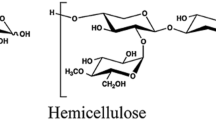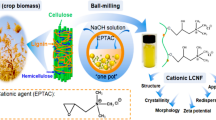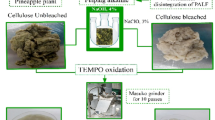Abstract
This work aimed to study the use of cellulose nanofibers (CNFs) from coir husk fibers to develop nanocomposite hydrogels. Cellulose and lignin were obtained from coir husk using the steam explosion pretreatment, followed by alkaline-ethanol-water pretreatment and bleaching process. CNFs from coir husk fibers were obtained using a high-speed blender on cellulose pulp previously oxidized with 2,2,6,6-tetramethylpiperidine-1-oxyl radical (TEMPO). Poly(N,N-dimethylacrylamide) (PDMA) was used as a matrix material to produce novel nanocomposite hydrogels reinforced with CNFs by a facile synthesis method. The compression modulus of PDMA/CNF hydrogels increased significantly when compared to PDMA hydrogel. The water-retention and nitrogen (N), phosphorous (P), and potassium (K) (NPK) fertilizer release studies indicated that the addition of CNFs considerably improved the water-retention capacity but reduced the nutrient loading capacity of the hydrogel. All the prepared nanocomposite hydrogels had significantly improved mechanical performance. Our study provides a facile and green route to produce CNFs and lignin. Furthermore, nanocomposite hydrogels with tunable properties for potential agriculture applications were prepared by homogeneously dispersing cellulose nanoparticles in PDMA.
Graphic abstract







Similar content being viewed by others
References
Afroz S, Afrose F, Alam A et al (2019) Synthesis and characterization of polyethylene oxide (PEO)-N, N-dimethylacrylamide (DMA) hydrogel by gamma radiation. Adv Compos Hybrid Mater 2:133–141
Bondancia TJ, de Aguiar J, Batista G et al (2020) Production of nanocellulose using citric acid in a biorefinery concept: effect of the hydrolysis reaction time and techno-economic analysis. Ind Eng Chem Res 59:11505–11516. https://doi.org/10.1021/acs.iecr.0c01359
Boufi S, Chaker A (2016) Easy production of cellulose nanofibrils from corn stalk by a conventional high speed blender. Ind Crops Prod 93:39–47. https://doi.org/10.1016/j.indcrop.2016.05.030
Chen C, Wang H, Li S et al (2017a) Reinforcement of cellulose nanofibers in polyacrylamide gels. Cellulose 24:5487–5493. https://doi.org/10.1007/s10570-017-1512-6
Chen Y, Geng B, Ru J et al (2017b) Comparative characteristics of TEMPO-oxidized cellulose nanofibers and resulting nanopapers from bamboo, softwood, and hardwood pulps. Cellulose 24:4831–4844. https://doi.org/10.1007/s10570-017-1478-4
Cipriano BH, Banik SJ, Sharma R et al (2014) Superabsorbent hydrogels that are robust and highly stretchable. Macromolecules 47:4445–4452. https://doi.org/10.1021/ma500882n
Crowe JD, Zarger RA, Hodge DB (2017) Relating nanoscale accessibility within plant cell walls to improved enzyme hydrolysis yields in corn stover subjected to diverse pretreatments. J Agric Food Chem 65:8652–8662. https://doi.org/10.1021/acs.jafc.7b03240
de Figueirêdo MCB, de Freitas RM, Ugaya CML et al (2012) Life cycle assessment of cellulose nanowhiskers. J Clean Prod 35:130–139
do Nascimento DM, Dias AF, de AraújoJunior CP et al (2016) A comprehensive approach for obtaining cellulose nanocrystal from coconut fiber. part II: environmental assessment of technological pathways. Ind Crops Prod 93:58–65
do Nascimento DM, Almeida JS, Vale MD et al (2016) A comprehensive approach for obtaining cellulose nanocrystal from coconut fiber. part I: proposition of technological pathways. Ind Crops Prod 93:66–75
do Nascimento ES, Pereira ALS, de Barros M et al (2019) TEMPO oxidation and high-speed blending as a combined approach to disassemble bacterial cellulose. Cellulose 26:2291–2302. https://doi.org/10.1007/s10570-018-2208-2
Dušek K (1979) Crosslinking and networks. Makromol Chem 2:35–49. https://doi.org/10.1002/macp.1979.020021979103
Feng Y-H, Cheng T-Y, Yang W-G et al (2018) Characteristics and environmentally friendly extraction of cellulose nanofibrils from sugarcane bagasse. Ind Crops Prod 111:285–291. https://doi.org/10.1016/j.indcrop.2017.10.041
Feuer M (2008) Assembly Bill No. 1879. Chapter 559. Hazardous materials: toxic substances. https://dtsc.ca.gov/wp-content/uploads/sites/31/2018/01/ab_1879_GCI.pdf
Freire ALF, de Araújo Júnior CP, de Freitas RM et al (2017) Environmental assessment of bioproducts in development stage: the case of fiberboards made from coconut residues. J Clean Prod 153:230–241
French AD (2014) Idealized powder diffraction patterns for cellulose polymorphs. Cellulose 21:885–896. https://doi.org/10.1007/s10570-013-0030-4
Gao J, Frisken BJ (2003) Cross-linker-free N-isopropylacrylamide gel nanospheres. Langmuir 19:5212–5216. https://doi.org/10.1021/la0269762
Gea S, Siregar AH, Zaidar E et al (2020) Isolation and characterisation of cellulose nanofibre and lignin from oil palm empty fruit bunches. Materials 13:2290. https://doi.org/10.3390/ma13102290
Gillet S, Aguedo M, Petitjean L et al (2017) Lignin transformations for high value applications: towards targeted modifications using green chemistry. Green Chem 19:4200–4233
Herbaut M, Zoghlami A, Habrant A et al (2018) Multimodal analysis of pretreated biomass species highlights generic markers of lignocellulose recalcitrance. Biotechnol Biofuels 11(1):1–17. https://doi.org/10.1186/s13068-018-1053-8
Huang S et al (2018) Nanocellulose reinforced P (AAm-co-AAc) hydrogels with improved mechanical properties and biocompatibility. Compos Part A: Appl Sci Manuf 112:395–404
Komatsu T, Yokoyama T (2021) Revisiting the condensation reaction of lignin in alkaline pulping with quantitativity part I: the simplest condensation between vanillyl alcohol and creosol under soda cooking conditions. J Wood Sci 67:1–12
Li M, Pu Y, Ragauskas AJ (2016a) Current understanding of the correlation of lignin structure with biomass recalcitrance. Front Chem 4:45
Li Y, Liu Y, Chen W et al (2016b) Facile extraction of cellulose nanocrystals from wood using ethanol and peroxide solvothermal pretreatment followed by ultrasonic nanofibrillation. Green Chem 18:1010–1018. https://doi.org/10.1039/C5GC02576A
Li T, Chen C, Brozena AH et al (2021) Developing fibrillated cellulose as a sustainable technological material. Nature 590:47–56
Liu X, Wen Y, Qu J et al (2019) Improving salt tolerance and thermal stability of cellulose nanofibrils by grafting modification. Carbohydr Polym 211:257–265
Malladi R, Nagalakshmaiah M, Robert M, Elkoun S (2018) Importance of agriculture and industrial waste in the field of nano cellulose and its recent industrial developments: a review. ACS Sustain Chem Eng 6:2807–2828
Marques FP, Silva LMA, Lomonaco D et al (2020) Steam explosion pretreatment to obtain eco-friendly building blocks from oil palm mesocarp fiber. Ind Crops Prod 143:111907
Modenbach AA, Nokes SE (2014) Effects of sodium hydroxide pretreatment on structural components of biomass. Trans ASABE. https://doi.org/10.13031/trans.57.10046
Mujtaba M, Khawar KM, Camara MC et al (2020) Chitosan-based delivery systems for plants: a brief overview of recent advances and future directions. Int J Biol Macromol 154:683–697
Nascimento DM, Nunes YL, Figueirêdo MC et al (2018) Nanocellulose nanocomposite hydrogels: technological and environmental issues. Green Chem 20:2428–2448
Oliveira TÍS, Rosa MF, Ridout MJ et al (2017) Bionanocomposite films based on polysaccharides from banana peels. Int J Biol Macromol 101:1–8
Oliveira MM, Curvelo AAS, Driemeier C (2018) Nanostructural evolution of sugarcane rind and pith submitted to hydrothermal pretreatments. J Renew Mater 6:152–159. https://doi.org/10.7569/JRM.2017.6341576
Overend RP, Chornet E (1987) Fractionation of lignocellulosics by steam-aqueous pretreatments. Philos Trans R Soc Lond Ser Math Phys Sci 321:523–536
Pakutsah K, Aht-Ong D (2020) Facile isolation of cellulose nanofibers from water hyacinth using water-based mechanical defibrillation: insights into morphological, physical, and rheological properties. Int J Biol Macromol 145:64–76. https://doi.org/10.1016/j.ijbiomac.2019.12.172
Pelissari FM, do Sobral PJ, Menegalli FC (2014) Isolation and characterization of cellulose nanofibers from banana peels. Cellulose 21:417–432. https://doi.org/10.1007/s10570-013-0138-6
Pereira ALS, do Nascimento DM, Morais JPS et al (2014) Improvement of polyvinyl alcohol properties by adding nanocrystalline cellulose isolated from banana pseudostems. Carbohydr Polym 112:165–172
Pinto LO, Bernardes JS, Rezende CA (2019) Low-energy preparation of cellulose nanofibers from sugarcane bagasse by modulating the surface charge density. Carbohydr Polym 218:145–153. https://doi.org/10.1016/j.carbpol.2019.04.070
Ramli RA, Lian YM, Nor NM, Azman NIZ (2019) Synthesis, characterization, and morphology study of coco peat-grafted-poly (acrylic acid)/NPK slow release fertilizer hydrogel. J Polym Res 26:1–7
Rosa M, Medeiros E, Malmonge J et al (2010) Cellulose nanowhiskers from coconut husk fibers: effect of preparation conditions on their thermal and morphological behavior. Carbohydr Polym 81:83–92
Sannigrahi P, Ragauskas AJ, Miller SJ (2010) Lignin structural modifications resulting from ethanol organosolv treatment of loblolly pine. Energy Fuels 24:683–689. https://doi.org/10.1021/ef900845t
Shahi N, Min B, Sapkota B, Rangari VK (2020) Eco-friendly cellulose nanofiber extraction from sugarcane bagasse and film fabrication. Sustainability 12:6015. https://doi.org/10.3390/su12156015
Sharma S, Tiwari S (2020) A review on biomacromolecular hydrogel classification and its applications. Int J Biol Macromol 162:737–747
Silva APM, Oliveira AV, Pontes SM et al (2019) Mango kernel starch films as affected by starch nanocrystals and cellulose nanocrystals. Carbohydr Polym 211:209–216
Sun S, Sun S, Cao X, Sun R (2016) The role of pretreatment in improving the enzymatic hydrolysis of lignocellulosic materials. Bioresour Technol 199:49–58. https://doi.org/10.1016/j.biortech.2015.08.061
Thakur S, Thakur VK, Arotiba OA (2018) History, classification, properties and application of hydrogels: an overview. In: Thakur V, Thakur M (eds) Hydrogels. Gels horizons: from science to smart materials. Springer, Singapore, pp 29–50. https://doi.org/10.1007/978-981-10-6077-9_2
Tinoco D, Ortega A, Burillo G et al (2018) Different hydrogel architectures synthesized by gamma radiation based on chitosan and N, N-dimethylacrylamide. MRS Commun 8:617–623. https://doi.org/10.1557/mrc.2018.78
Wei J, Chen Y, Liu H et al (2016) Thermo-responsive and compression properties of TEMPO-oxidized cellulose nanofiber-modified PNIPAm hydrogels. Carbohydr Polym 147:201–207. https://doi.org/10.1016/j.carbpol.2016.04.015
Xiong B, Loss RD, Shields D et al (2018) Polyacrylamide degradation and its implications in environmental systems. NPJ Clean Water 1:1–9
Yang J, Han C, Xu F, Sun R (2014) Simple approach to reinforce hydrogels with cellulose nanocrystals. Nanoscale 6:5934–5943
Yang M, Zhang X, Guan S et al (2020) Preparation of lignin containing cellulose nanofibers and its application in PVA nanocomposite films. Int J Biol Macromol 158:1259–1267. https://doi.org/10.1016/j.ijbiomac.2020.05.044
Zhou Y, Fu S, Zhang L, Zhan H (2013) Superabsorbent nanocomposite hydrogels made of carboxylated cellulose nanofibrils and CMC-g-p(AA-co-AM). Carbohydr Polym 97:429–435. https://doi.org/10.1016/j.carbpol.2013.04.088
Acknowledgments
The authors acknowledge the financial support provided by CAPES, INOMAT, FUNCAP (PR2-0101-00023.01.00/15), CNPq (405766/2013-0), PRONEX, and the Laboratory of Pulp and Paper Science and Graphic Arts (LGP2, Grenoble Alpes University, Grenoble, France). They thank the Central Analítica-UFC/CT-INFRA/MCTI-SIS-NANO/Pró-Equipamentos CAPES for the SEM micrographs, as well as Dr. C. Muniz for STEM micrographs and Dr. F. Avelino for NMR spectra. We also thank the CNPq for the Research Productivity Fellowships granted to authors Leitão, Feitosa and Rosa. LGP2 is part of the LabEx Tec 21 (Investissements d’Avenir-grant agreement n°ANR-11-LABX-0030) and of the PolyNat Carnot Institut (Investissements d’Avenir-grant agreement n°ANR-11-CARN-030-01).
Author information
Authors and Affiliations
Corresponding author
Ethics declarations
Conflict of interest
The authors declare that they have no conflict of interest and that the manuscript has not been published elsewhere, is not under editorial review for publication elsewhere, and is not being submitted simultaneously to another journal.
Human and Animal Rights
This article does not contain any studies involving animals or human participants performed by any of the authors.
Additional information
Publisher's Note
Springer Nature remains neutral with regard to jurisdictional claims in published maps and institutional affiliations.
Supplementary Information
Below is the link to the electronic supplementary material.
Rights and permissions
About this article
Cite this article
do Nascimento, D.M., Nunes, Y.L., de Almeida, J.S. et al. Development of an integrated process to produce CNFs and lignin and its potential applications for agrochemical delivery. Cellulose 28, 10891–10904 (2021). https://doi.org/10.1007/s10570-021-04200-2
Received:
Accepted:
Published:
Issue Date:
DOI: https://doi.org/10.1007/s10570-021-04200-2




